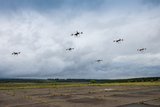US Navy foresees an uncrewed future for its surface and underwater fleet
The service has been conducting various procurement and development efforts to integrate unmanned surface and underwater vehicles into its inventory.
Sonardyne has partnered with Guidance Marine for a project that will help unmanned autonomous vessels navigate even when they lose access to global navigation satellite systems (GNSS).
The project will combine Sonardyne’s underwater positioning systems and Guidance Marine’s relative surface positioning systems into one integrated solution to enable vessels to maintain safe passage in GNSS-denied environments or for dynamic positioning systems to maintain their position if they lose GNSS access or other sensors fail.
The Innovate UK-backed project will also create a common interface structure to allow the different sensors to be fed into one platform and develop an industry standard.
The system uses Sonarydne’s SPRINT-Nav all-in one subsea navigation instrument, which combines Sonardyne’s SPRINT INS solution, Syrinx Doppler Velocity Log (DVL) and a high accuracy pressure sensor, into one integrated unit. The tight integration enables highly accurate acoustic-aided positioning by integrating sensor data from the DVL and/or other acoustic positioning inputs.
Additionally, it takes in position data provided by Guidance Marine’s vessel-mounted CyScan laser instrument, which takes range and bearing measurements from targets mounted on buildings or stationary surface structures in the ocean, to calculate the vessel’s position and maintain positioning between targets.
During trials earlier in 2018, a CyScan was mounted on Sonardyne’s Echo Explorer survey vessel incorporating additional GeoLock functionality. During a transit from Plymouth to Turnchapel the two instruments were used to calculate Echo Explorer’s position. Less than 0.5m positional deviation over a 1km transit was achieved during the trial, when compared with local, shore-based RTK GPS data.
Ongoing trials will incorporate water track velocity data, using Sonardyne instruments, to further aid the INS positioning. Guidance Marine will also deploy its SceneScan product, which maps surface features of structures, such as offshore oil platforms, processes point cloud data and applies simultaneous localisation and mapping techniques to provide relative position data.

The service has been conducting various procurement and development efforts to integrate unmanned surface and underwater vehicles into its inventory.

Tekever has manufactured the AR3, AR4 and AR5 UAS with all systems sharing common electronics and software architecture, which has enabled the reuse of ground segment elements within the new ARX UAS.

As the dynamics of aerial combat rapidly evolve, Chinese scientists have engineered a sophisticated air separation drone model that can fragment into up to six drones, each capable of executing distinct battlefield roles and challenging the efficacy of current anti-drone defences such as the UK’s Dragonfire laser system.

Advancements in air defence technologies have begun to reshape aerial combat dynamics in the Middle East, as illustrated by recent events involving the Israeli Air Force and Hezbollah.

Both sides of the Russia-Ukraine war have been using UAS for effective low-cost attacks, as well as impactful web and social media footage. Thousands more have now been committed to Ukrainian forces.

The US Army has intentions to develop light, medium and heavy variants of the Robotic Combat Vehicle (RCV) as part of the branche’s Next Generation Combat Vehicle family.